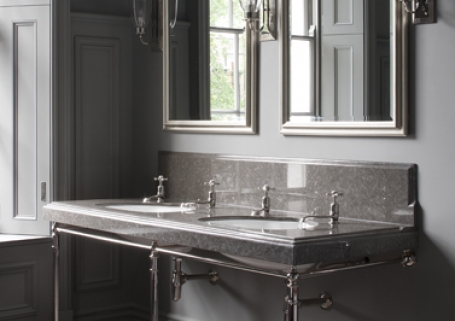Use British limestone in your home
You don't have to go all the way to Italy to find stunning stone to use in your house - British limestone is undergoing a renaissance of its own


Italian marble is facing a new, older contender for eye-catching floors and bathroom pieces in today's country houses. Mark Hedges salutes the rebirth of British polished limes
It's rarely acknowledged publicly, but Britain's geology is the real wonder behind our nation's beauty. In England, chalk gives shape to the North and South Downs, clay to the Weald, granite to the wild West Country moors, millstone grit to the wilderness of the North and limestone to much of the Peak District and, of course, the Cotswolds. Scotland possesses the ancient volcanoes that form the Cairngorms and the remnants of a sea that was once wider than the Atlantic. Wales has the sandstone of the Brecon Beacons and the coal that fired the Industrial Revolution.
All our treasured rural idylls have been given shape and form by the rock and stone that underpin the landscape above. And in Britain, we are blessed with more varied types of rock than anywhere else in the world of comparable size. This stone is not so much made in Britain-it made Britain. Among all this contrasting geology are a few types of limestone that can be transformed into glistening, shining stones, something that was first discovered by the Romans, who recognised that some British stones could be polished into what they called marmor, now the Italian marmo.
Although technically not marble (marble is a metamorphic rock that has been subjected to heat and pressure that cause the minerals within it to recrystallise), Britain's polished limestones reveal a vast array of glorious blacks, greys, browns, purples, reds and greens. Some are almost pure white; others are traced through with fossils -something no marble can boast.
These stones were used for Nelson's tomb, York Minster, Durham Cathedral and St Paul's Cathedral, as well as in the famous checkerboard floor in the Painted Hall at Chatsworth and at hosts of other great houses, but they fell out of favour due to the advent of the Grand Tour and the new fashion for European stone. Since the Industrial Revolution, our native ‘marbles' have been blasted and crushed into road aggregate and even used in toothpaste. Their glory seemed to have passed out of time, until now. Orlando Boyne is a remarkable man. A wild-haired gentleman of immense charm, he discovered, almost by accident, our lost stone heritage. ‘I found that I had to make a cantilevered staircase in a foreign stone because I was told that there was no British stone that was capable of doing the job. This frustrated me as it simply wasn't true. Staircases had been made out of British stone from the 17th century. It wasn't that British stones couldn't do the job, but that they had been "lost".' After he was encouraged by Graham Lott of the British Geological Survey to read his article The Shining Stone of Britain, in 2010, Britannicus Stone was born.
Now, the firm's new materials and production director, Mr Boyne talks in awe about his discoveries. ‘The whereabouts of the stones and their quarries had been lost in time. I found them through internet searching and discussions with the Minerals Officers about the various counties that had carboniferous limestone deposits. I then searched and searched. It's a bit like the story of the Ugly Duckling-you find nondescript blocks of grey, brown or black, but once it's cut and polished, you reveal the swan. I'm still looking for more stones. Discoveries are so exciting.'
These polished shining stones with evocative names such as Swaledale Fossil, Salterwath, Frosterley Marble Hopton Old White, Eskett Red and Anglesey Veined Marble are now competing with foreign imports and can be cut into vast slabs up to 8ft high.
Exquisite houses, the beauty of Nature, and how to get the most from your life, straight to your inbox.

Anglesey marble is popular in bathrooms
Every piece is unique. They are used by interior designers and architects for floors, walls, cladding of showers, vanity tops, bowls, basins and baths, staircases and fireplaces. The British provenance has struck a chord with clients, who are delighted in its rarity, beauty and, for some, patriotic values. I've recently purchased some Swaledale Fossil, flecked with crinoid fossils, for my new bathroom-its other home is in Durham Cathedral in the city where I went to university.
I love its beauty and the connection. Demand has risen so steeply for the spectacular Pooilvaaish Black stone, first used by monks at Rushen Abbey on the Isle of Man back in the 14th century, that the company has bought the quarry to meet the demand for this jet-black marvel. Mr Boyne's rediscovery of our beautiful, lost stone treasures is a wonder. It is as if he has found a masterpiece lost to the nation, but, thanks to his vision, Britain's shining stones are back where they belong. Britannicus Stone: 020-7751 5962; www.britannicus-stone.co.uk.
* Follow Country Life Magazine on Twitter
Country Life is unlike any other magazine: the only glossy weekly on the newsstand and the only magazine that has been guest-edited by His Majesty The King not once, but twice. It is a celebration of modern rural life and all its diverse joys and pleasures — that was first published in Queen Victoria's Diamond Jubilee year. Our eclectic mixture of witty and informative content — from the most up-to-date property news and commentary and a coveted glimpse inside some of the UK's best houses and gardens, to gardening, the arts and interior design, written by experts in their field — still cannot be found in print or online, anywhere else.
